Flaky Gluten Free Pie Crust Recipe
This easy gluten-free pie crust tastes just as delicious as the white-flour crusts of my childhood! It's ultra flaky with a classically rich, buttery flavor. Best of all, with just a few simple techniques, making perfect pie crust is way easier than you might think. I’ve included a step-by-step video on how to do it below - never fear pie crust again! (If you do eat gluten you can use this same recipe and technique using regular all-purpose flour.)
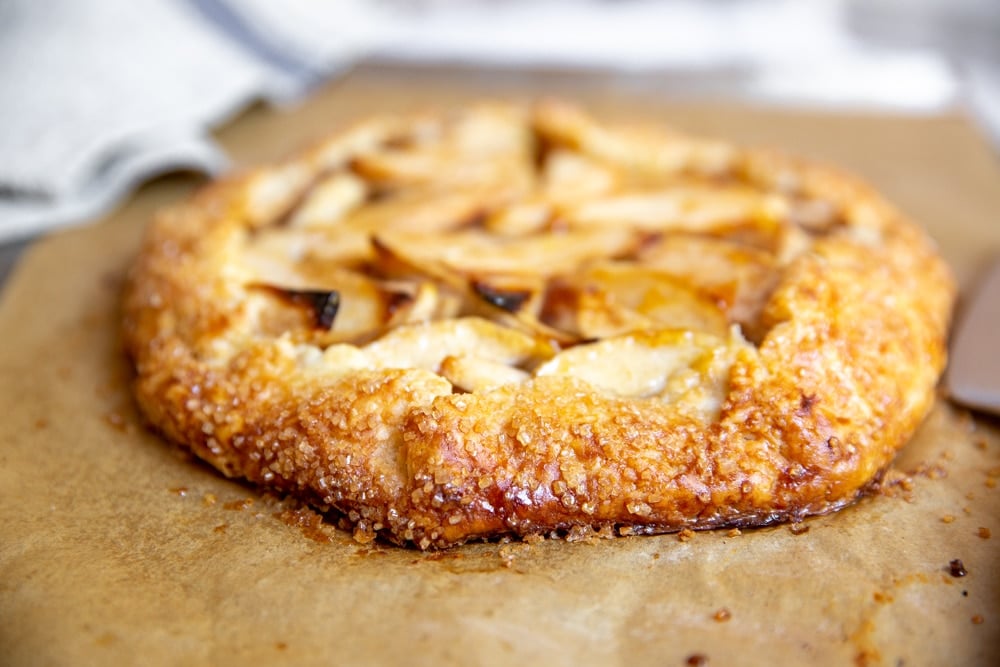
Best gluten free flour for pie crust
After testing dozens of gluten free flour brands, I found Cup 4 Cup flour to have the best flavor and texture by far in pie crust (this is not a paid endorsement or sponsored post!). It was also much easier to work with than other gluten free flours, which tended to be crumbly and hard to roll. If you'd rather make a gluten free flour blend from scratch, sign up for my class, Mastering Gluten Free Pie Making, where you'll learn my homemade gluten-free flour for pie dough!
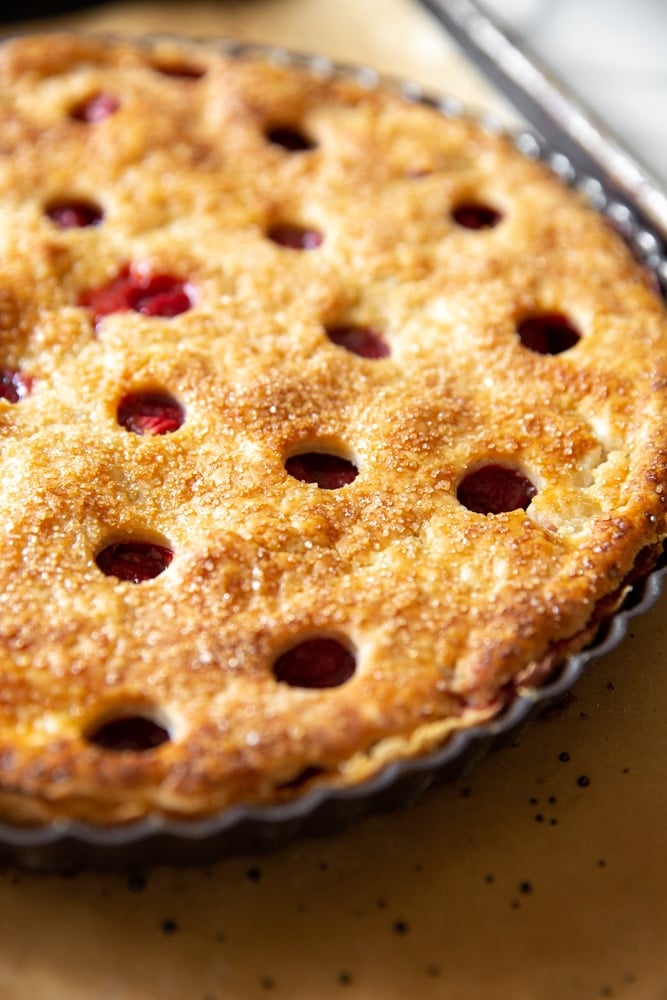
Gluten free pie crust ingredients (simple and easy)
- Cup 4 Cup gluten free flour (if you're not GF you can use regular all-purpose flour)
- Fine sea salt
- Sugar (a touch of sugar gives the crust a delicious flavor and helps it brown, but it can be omitted)
- Butter (preferably a European style butter, see below)
- Apple cider vinegar (a splash of apple cider vinegar helps ensure a flaky texture)
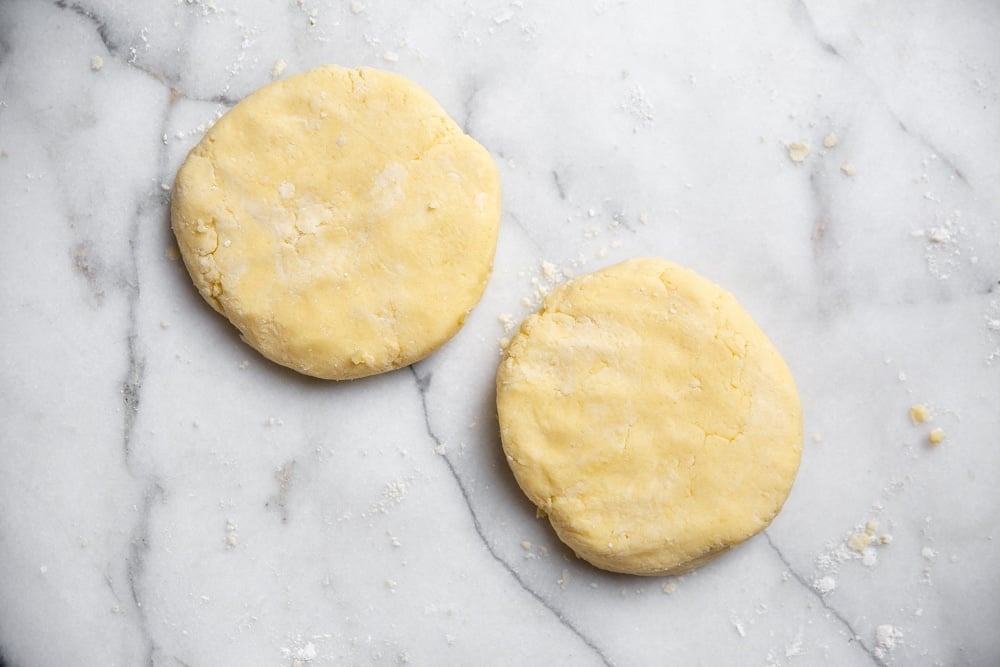
How to make gluten free pie crust
- First, use good-quality, European style butter (such as Kerrygold or Plugra), which has a higher fat content and will make rolling and working the dough much easier (not to mention that it will taste better). Cut the butter into about ½-inch sized pieces and put it in the fridge. Cold butter is key.
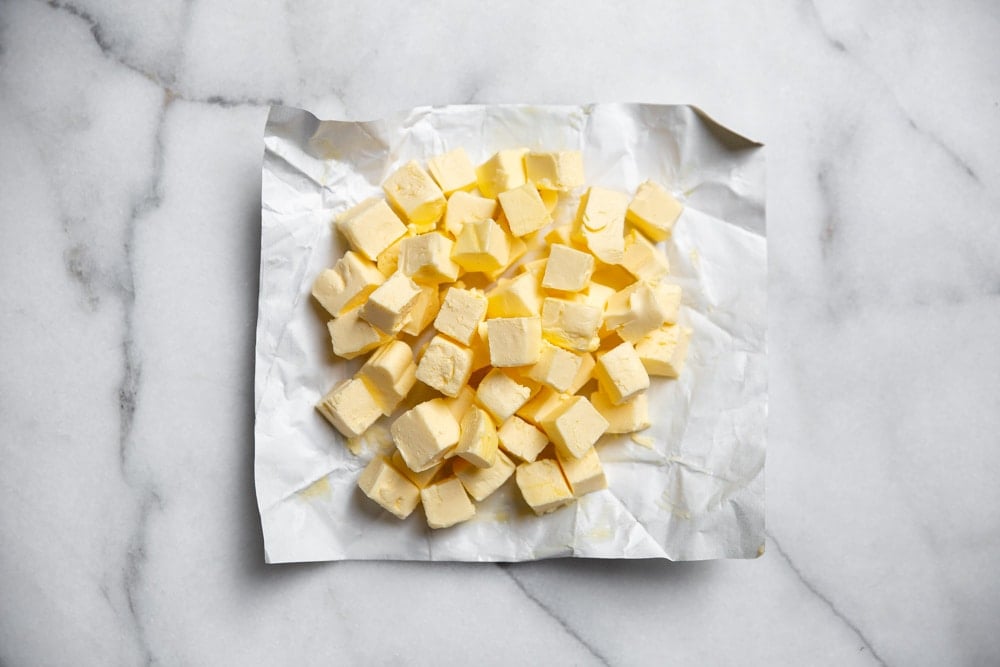
- In a food processor, add the flour (Cup 4 Cup or all-purpose), salt and sugar. Pulse to combine. You can also make pie dough using your hands or a pastry cutter (although a food processor is faster) - whisk the dry ingredients to combine.
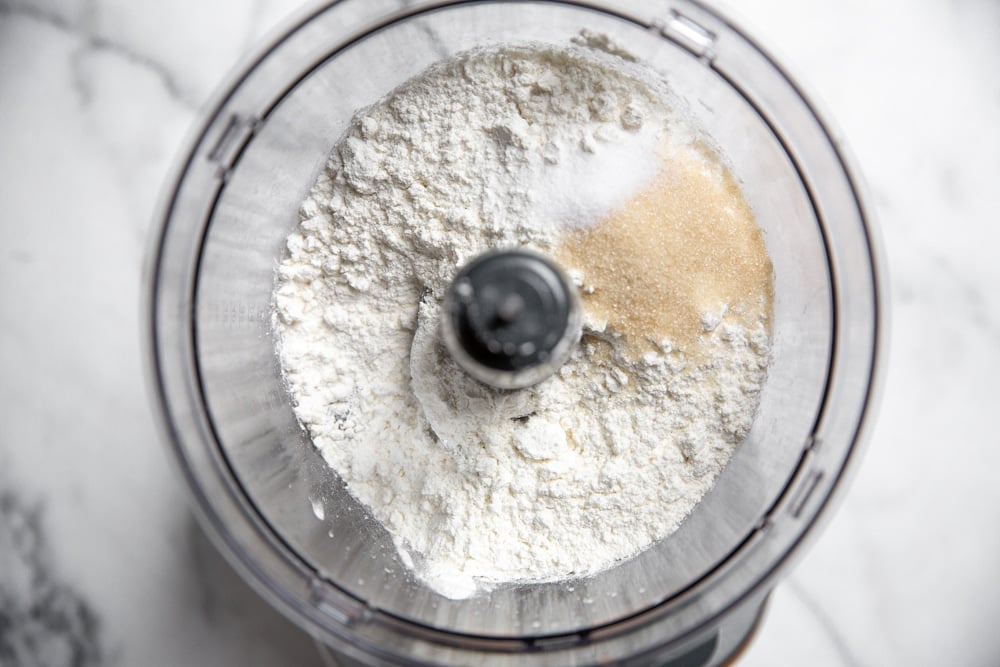
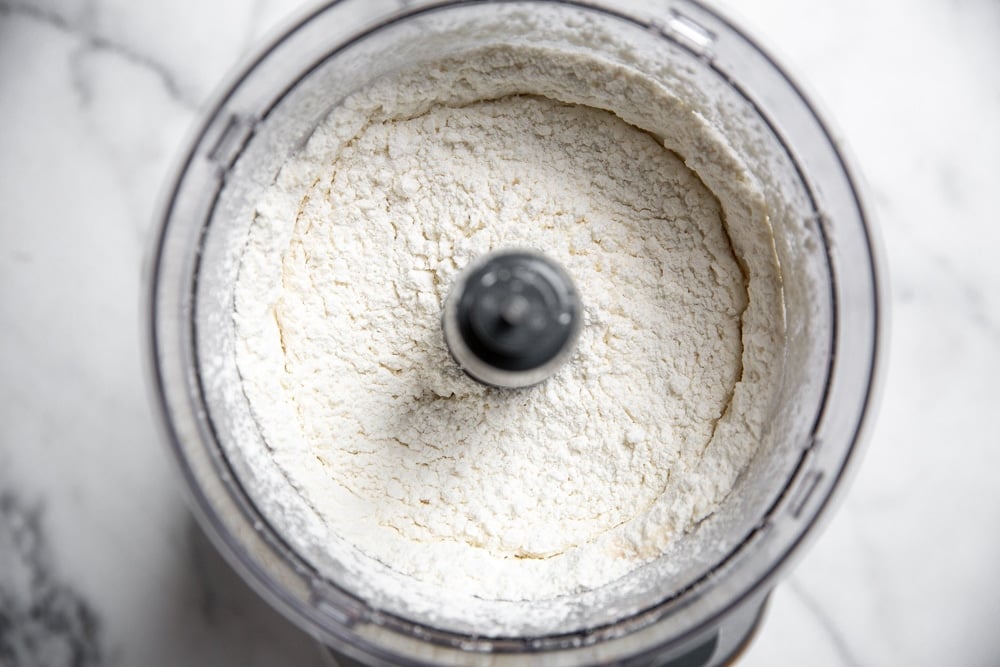
- Sprinkle the cold butter cubes over the flour and pulse just until the mixture is somewhat crumbly and there are still pea-sized (or slightly larger) chunks of butter (or use a pastry cutter to work the butter into the flour). Don’t over-mix the flour and butter, because those chunks equal a flaky crust.
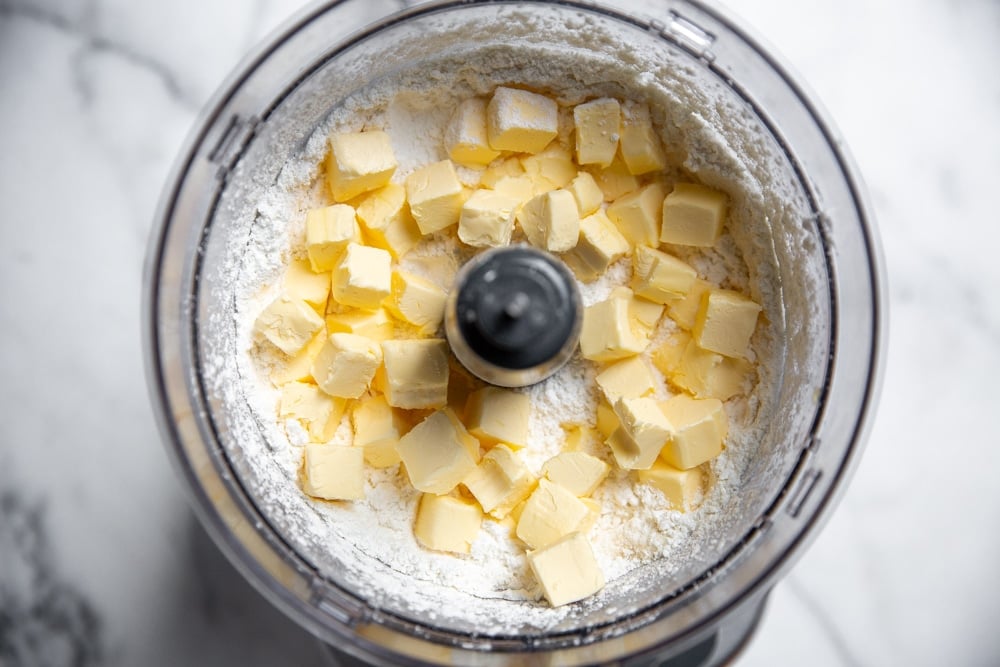

- Next, drizzle a bit of apple cider vinegar over top (this helps with flakiness). Put the lid back on, start the machine, and immediately start to drizzle in cold water. You want to add just enough water so that the dough sticks together when pinched—it should still look shaggy and a bit floury.
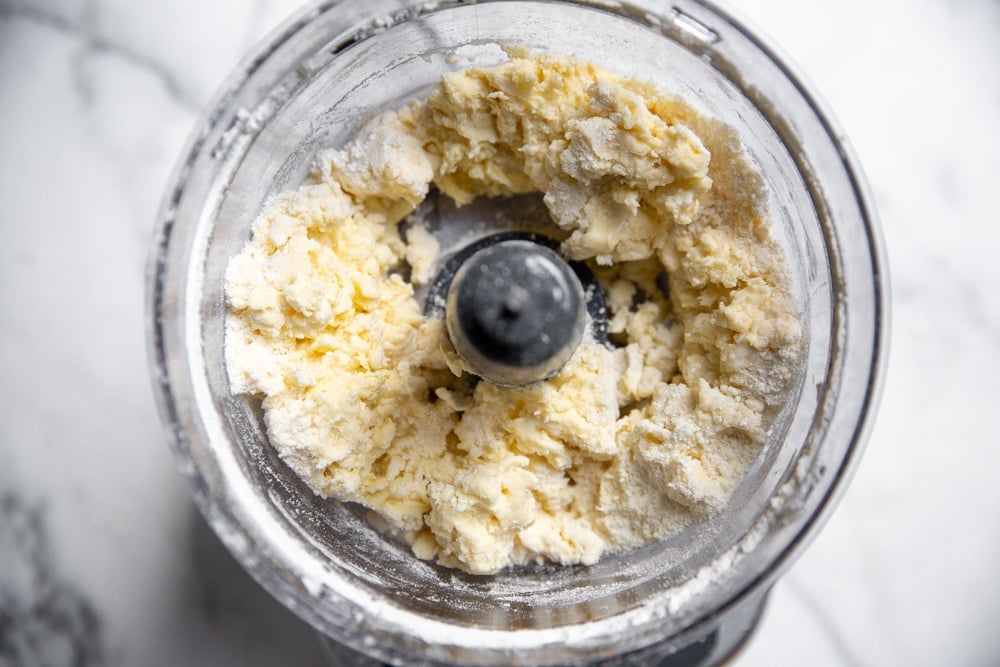
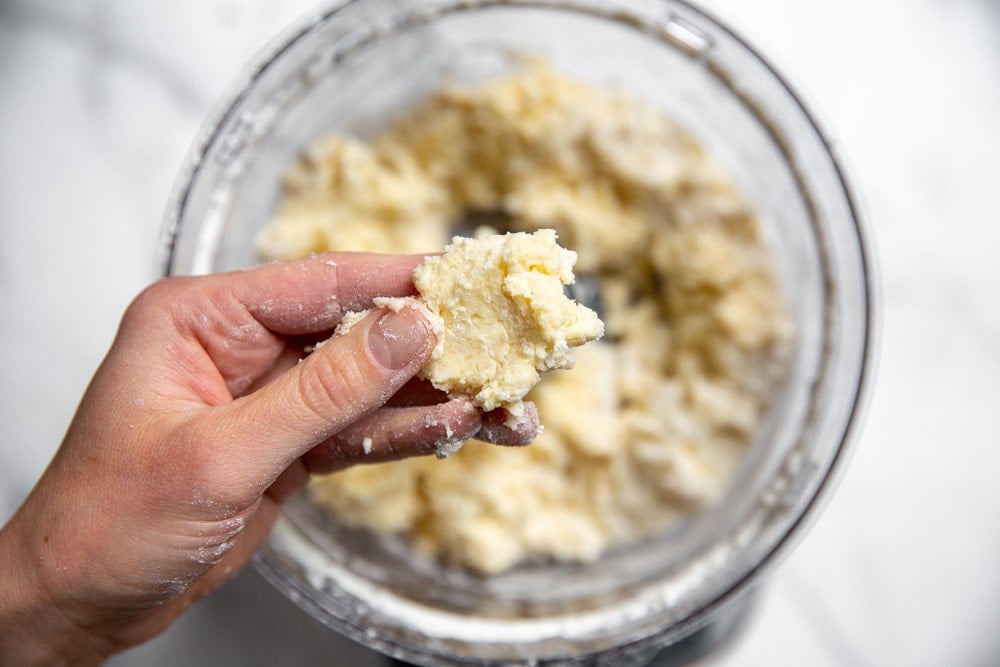
- Finally, transfer the dough to a lightly floured work surface, and use your hands to form it into a ball. Divide the dough ball in half, then press the dough into two disks. Cover the disks with plastic wrap, and refrigerate them for at least 30 minutes.


Can you make the dough ahead?
Yes! The dough can be refrigerated for up to 2 days or frozen for up to 3 months. Meaning you can go ahead and whip up the pie crusts for your holiday pies months in advance! (And if you're like me, nothing will bring you more joy than discovering a ready-made disk of pie dough in the freezer.)
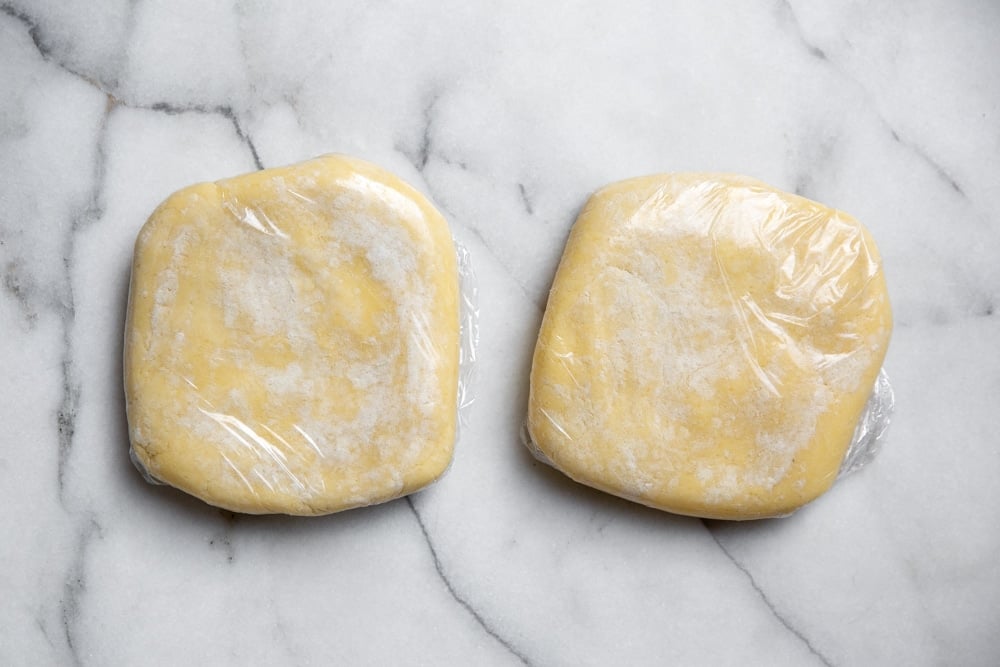
How can you use gluten free pie dough?
You can use this dough in any pie, tart or galette recipe (sweet or savory!). The dough makes enough for one 9-inch double crust pie, or 2 single crust pies (or 2 galettes). Whether it's your favorite berry pie or a savory egg quiche, this crust won't let you down. Don't miss my strawberry galette recipe, rhubarb galette with almond frangipane filling, apple galette, blueberry hand pies, savory spinach galette and chicken pot pie!
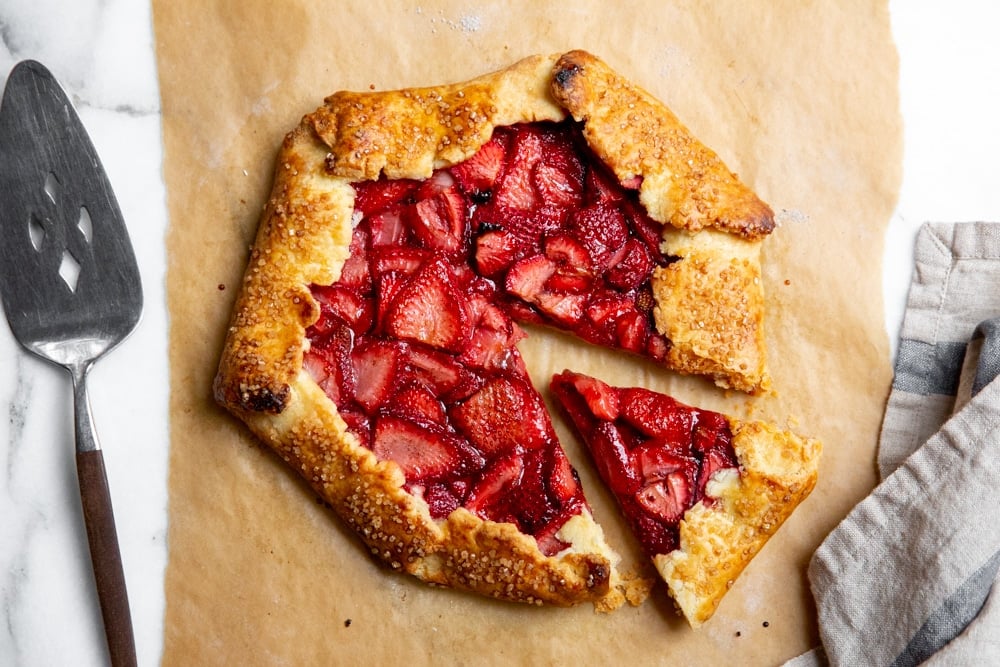
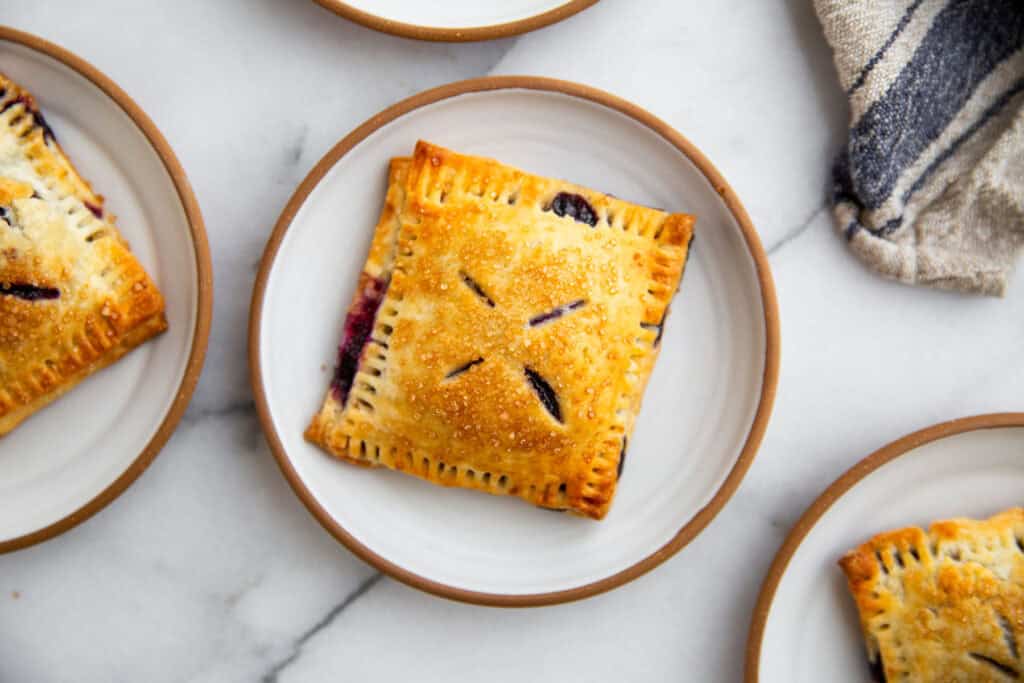
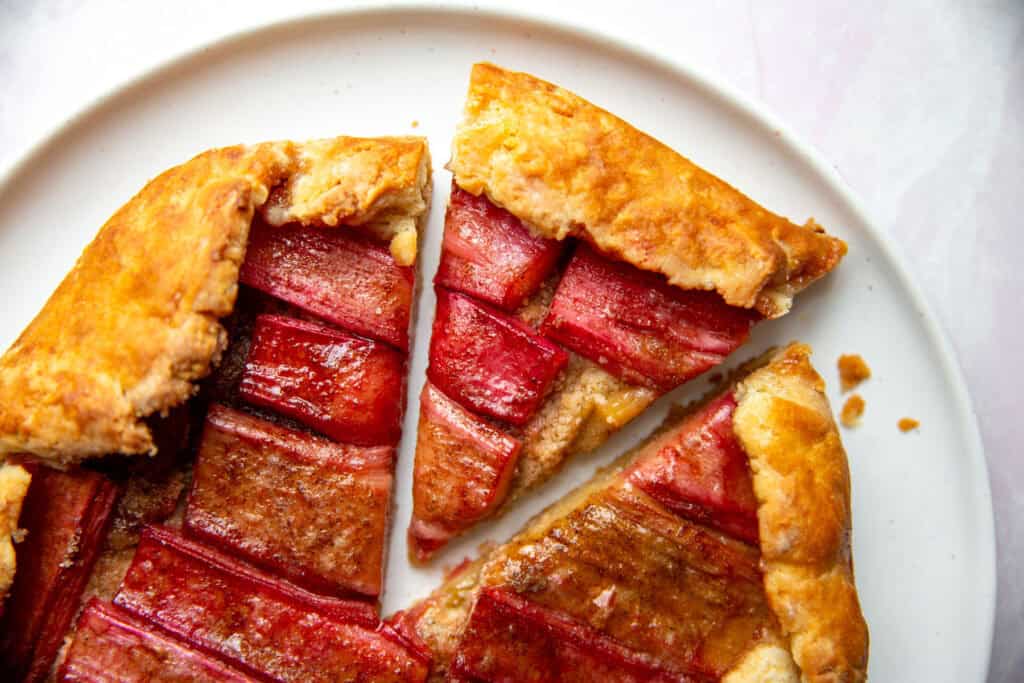

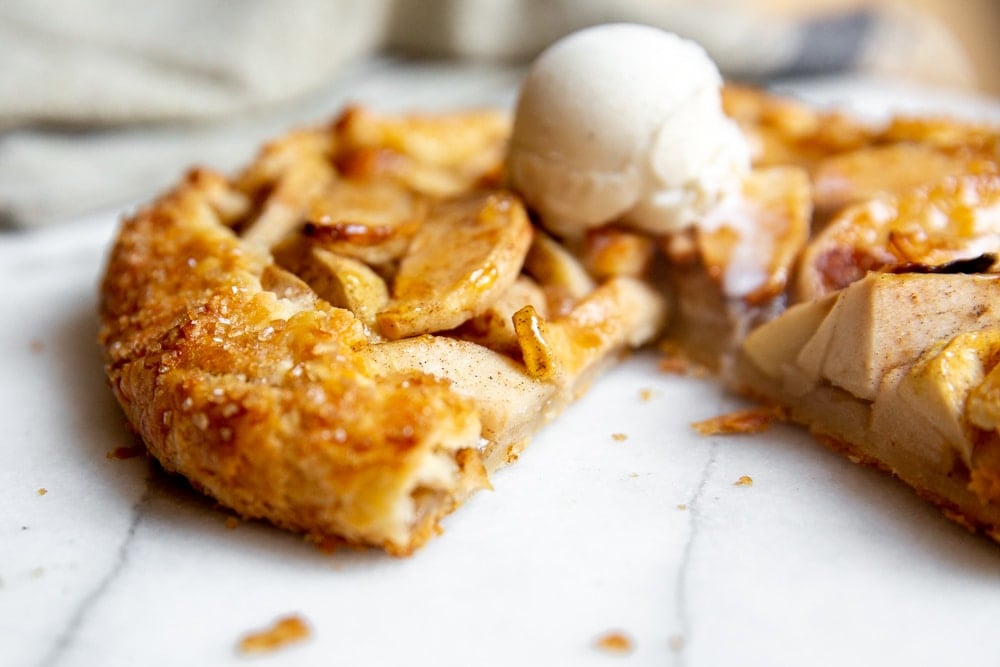
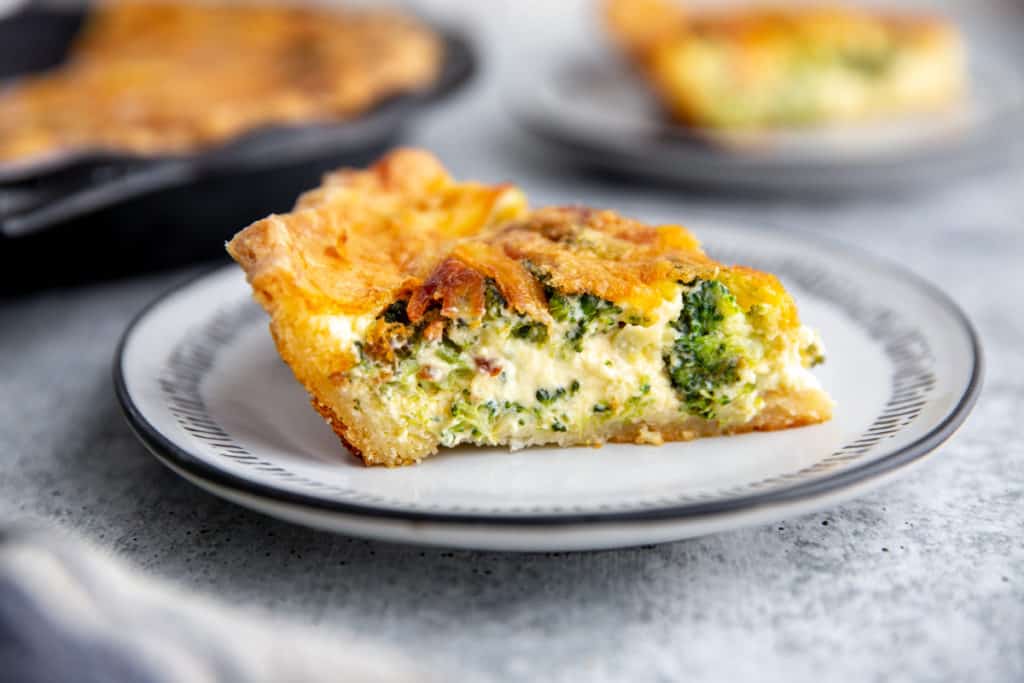
Tips for making gluten free pie crusts:
- Roll the dough out on a lightly floured piece of parchment paper to prevent sticking.
- For a beautifully browned crust, brush the dough with egg wash before baking (I also love sprinkling it with turbinado or demerara sugar for added sweetness and crunch).
- Using a glass pie plate allows you to see the bottom of the crust, ensuring that it is nicely browned before removing the pie from the oven.
- If the top of the pie gets too dark before the filling is fulling cooked, tent it with aluminum foil.
- If you don't have a food processor you can make this dough by hand. Whisk the dry ingredients in a large bowl, then add the cold butter cubes. Using your fingers (or a pastry cutter), rub the butter into the flour mixture, toss and smashing it until it's incorporated but you still see larger pea sized chunks. Drizzle in the apple cider vinegar and cold water, then toss with a fork until the dough comes together. From there you can turn it out onto a floured piece of parchment paper as indicated in the recipe.
- For more pie tips, check out this Gluten Free Pie Recipes post!
*This post contains Amazon and other affiliate links to products I use and love (from which I earn income, at no cost to you). Thank you for supporting From Scratch Fast!
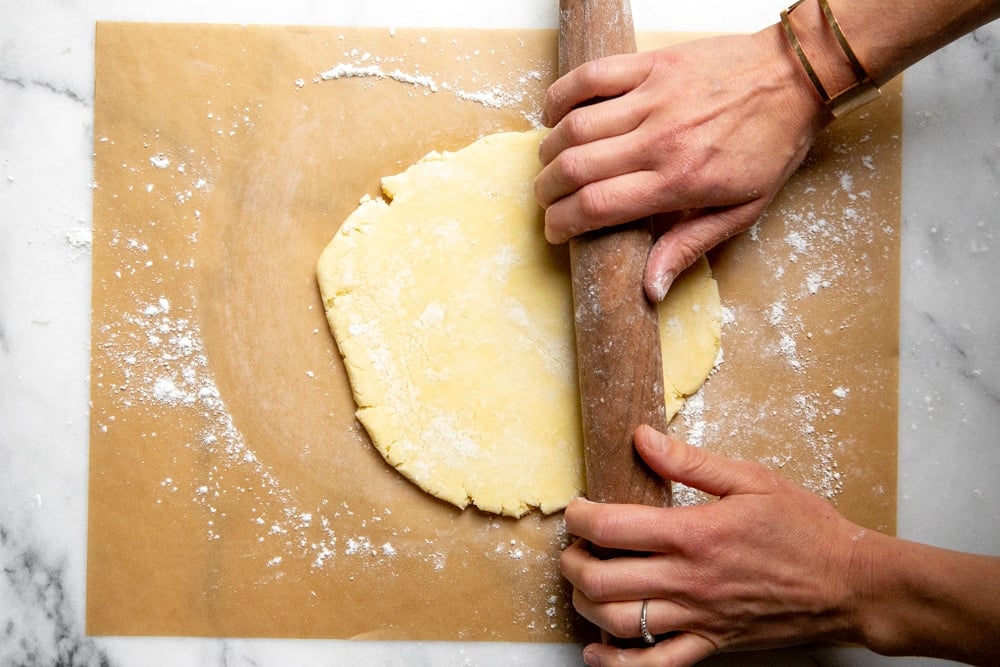
I've included more tips in the recipe below for rolling out the dough and for making both single- and double-crust pies. Here's to a season (no, let's make that a YEAR) of fearless, delicious pie baking!
FAQs
Yes! You can make the dough several months in advance! Wrap the dough in plastic wrap, then freeze it in a zip-top freezer bag (defrost the dough overnight in the refrigerator before using). Alternatively, refrigerate the dough (tightly wrapped) for up to 2 days.
This gluten free pie crust is virtually indistinguishable from regular pie crust! It is ultra flaky, with a rich, buttery flavor.
This recipe calls for Cup 4 Cup gluten free flour. After testing several different store-bought all-purpose flour blends, Cup 4 Cup had the best flavor and texture and was far easier to work with than other flours.
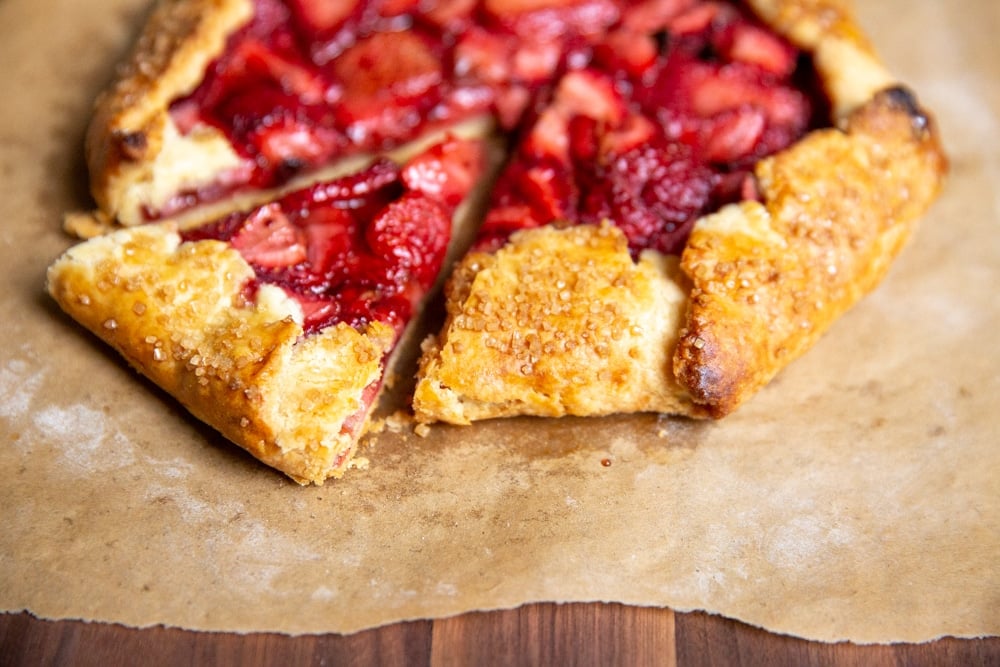
Use this gluten free pie crust in these recipes:
- Easy Strawberry Galette
- Cinnamon Vanilla Apple Galette
- Blueberry Hand Pies
- Broccoli Cheddar Quiche
- Savory Spanakopita Spinach Galette
- Chicken (or Turkey!) Pot Pie
Other easy gluten free desserts to try:
- Gluten Free Carrot Cake (Naturally Sweetened)
- No-Bake Mascarpone Cheesecake
- Healthy Almond and Coconut Cake
- DIY Ice Cream Cake
- Homemade Gluten Free Strawberry Shortcakes
- Individual Chocolate Flourless Cakes
Watch the video!
Stay connected
I'd love to answer any of your questions and see what you're cooking!! Don't forget to give this recipe a star rating and leave a comment below. Follow along on Instagram, Facebook, YouTube & Pinterest, and be sure to tag @nickisizemore so that I can share your creations!
Get the recipe!
Easy Gluten Free Pie Crust (the best crust ever!)
Ingredients
- 2 ½ cups (326g / 11.5oz) Cup4Cup brand gluten-free flour OR 2 ½ cups (319g / 11.25oz) all-purpose flour, plus more for workspace
- ½ teaspoon fine sea salt
- 1 tablespoon sugar (optional; this can be omitted for savory crusts)
- 2 sticks (8 ounces) unsalted, good quality butter (preferably a cultured or European style butter), cut into ½-inch dice
- 1 teaspoon apple cider vinegar
- ⅓ - ½ cup cold water
Instructions
- Put the flour, sea salt and sugar, if using, in a food processor and pulse to combine.
- Sprinkle the cold butter over the flour in the food processor. Pulse until the mixture looks crumbly with larger, pea-sized chunks of butter (those chunks of butter equal a flaky crust!). Drizzle the apple cider vinegar over top.
- Turn the machine on and immediately start drizzling cold water through the feed tube. Stop the machine once the mixture starts to come together and looks shaggy. Give the dough a pinch—if it sticks together, it’s ready to go. If not, turn the machine on again and drizzle in a bit more water. You might not need all of the water—you’re looking for a shaggy dough, not a cohesive ball.
- Transfer the dough to a lightly floured surface and shape it into a ball. Divide the dough into 2 equal pieces and form each into a flat disk. Wrap the disks in plastic wrap and refrigerate them for at least 30 minutes or for up to 2 days. Do Ahead: The wrapped disks can be placed in zip-top freezer bags and frozen for up to 3 months. Thaw in the refrigerator overnight before using.
- If the dough has been in the fridge for several hours, let it sit at room temperature until slightly softened, about 10-20 minutes. Roll it out on a lightly floured piece of parchment paper. If the dough immediately starts to crack once you start rolling, it’s too cold—give it a few more minutes to warm up. If the edges crack as you roll (which they probably will, so no fear!) simply patch them as needed.
Single Crust Pie
- To blind bake a single pie crust: Preheat the oven to 400˚F. Transfer the dough to a 9-inch pie plate, making sure to get in the corners. Using kitchen scissors, trim the dough to a ½-inch overhang. Fold the overhang under to form a ring around the pie plate. Crimp the ring, if you’d like. At this point, if the dough feels like it’s getting soft, pop the pie plate in the fridge or freezer for a few minutes to firm up. Prick the bottom all over with a fork. Line the crust with a large piece of parchment paper then pour in dried beans or pie weights to completely cover the bottom. Bake 15 minutes. Remove the parchment and beans. Bake 5 minutes longer, or until light golden on the bottom. Do Ahead: The crust can be blind baked up to 1 day in advance.
Double Crust Pie
- To make a double-crust pie: Preheat the oven to 400˚F. Roll out one disk of dough, and transfer it to a 9-inch pie plate, making sure to get in the corners. Add your fruit filling, and dot with butter. Roll out the second piece of dough and lay it over top. Using kitchen scissors, trim the dough to a ½-inch overhang. Roll the overhang under (pinching the top and bottom dough together) to form a ring around the pie plate. Crimp the ring, if you’d like. At this point, if the dough feels like it’s getting soft, pop the pie in the fridge or freezer for a few minutes to firm up. Brush the top dough with egg wash and sprinkle with sugar. Using a small knife, cut a few vents on top. Bake 35 minutes. Reduce the oven temperature to 350˚F and bake 15-30 minutes longer, or until the fruit is tender and bubbling. If needed, lightly tent the top crust or edges if they start to look too brown near the end of cooking.
Notes
- I use Cup 4 Cup Gluten Free Flour for this pie crust, which rolls out easily and tastes like a traditional pie crust. You can also use Bob's Red Mill 1-to-1 Gluten-Free Baking Flour, but the dough will be much crumblier and can be hard to transfer (it works best as a galette). If you're not gluten-free, you can use any regular all-purpose flour.
- Use a good quality European-style butter, such as Kerrygold, Plugra or Organic Valley.
- Don't over-process the butter and flour mixture. The small chunks of butter will give you a flakier crust!
- The finished dough will still look shaggy and a bit floury in the food processor. Don't over-process, otherwise you'll end up with a tough crust. The dough will come together on the countertop once you form it into a ball.
- If you don't have a food processor you can make this dough by hand. Whisk the dry ingredients in a large bowl, then add the cold butter cubes. Using your fingers (or a pastry cutter), rub the butter into the flour mixture, toss and smashing it until it's incorporated but you still see larger pea sized chunks. Drizzle in the apple cider vinegar and cold water, then toss with a fork until the dough comes together. From there you can turn it out onto a floured piece of parchment paper as indicated in the recipe.
- Use the pie dough in this easy strawberry galette recipe, this cinnamon and vanilla spiced apple galette, this savory spinach galette , this Broccoli Cheddar Quiche or this gluten-free chicken pot pie!
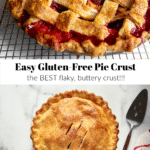
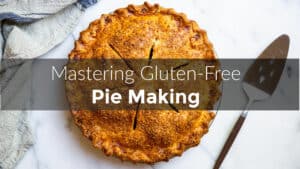
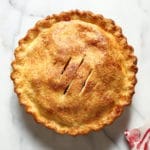


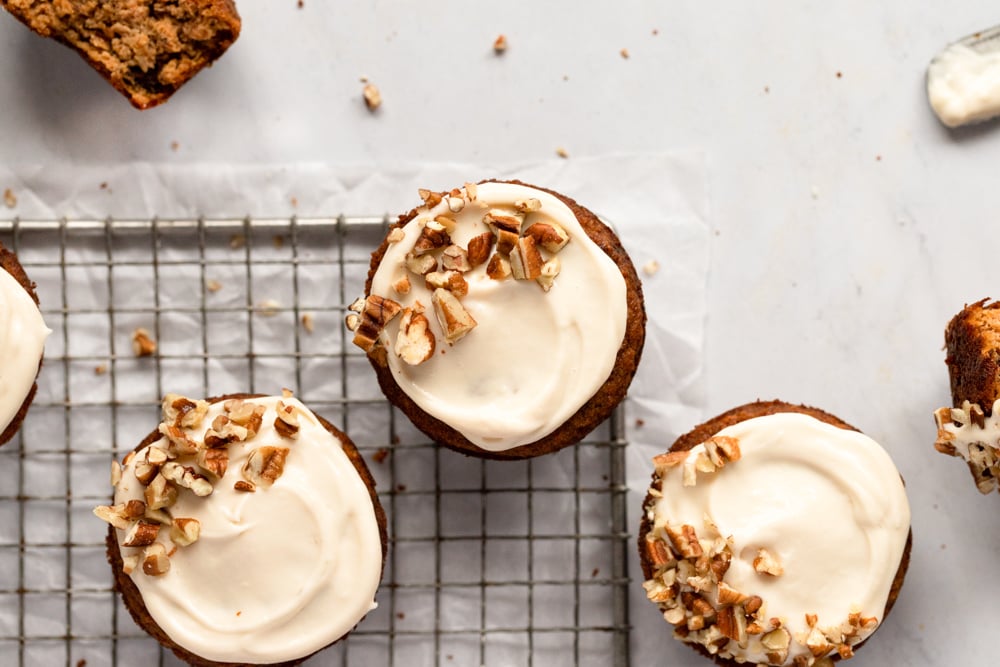

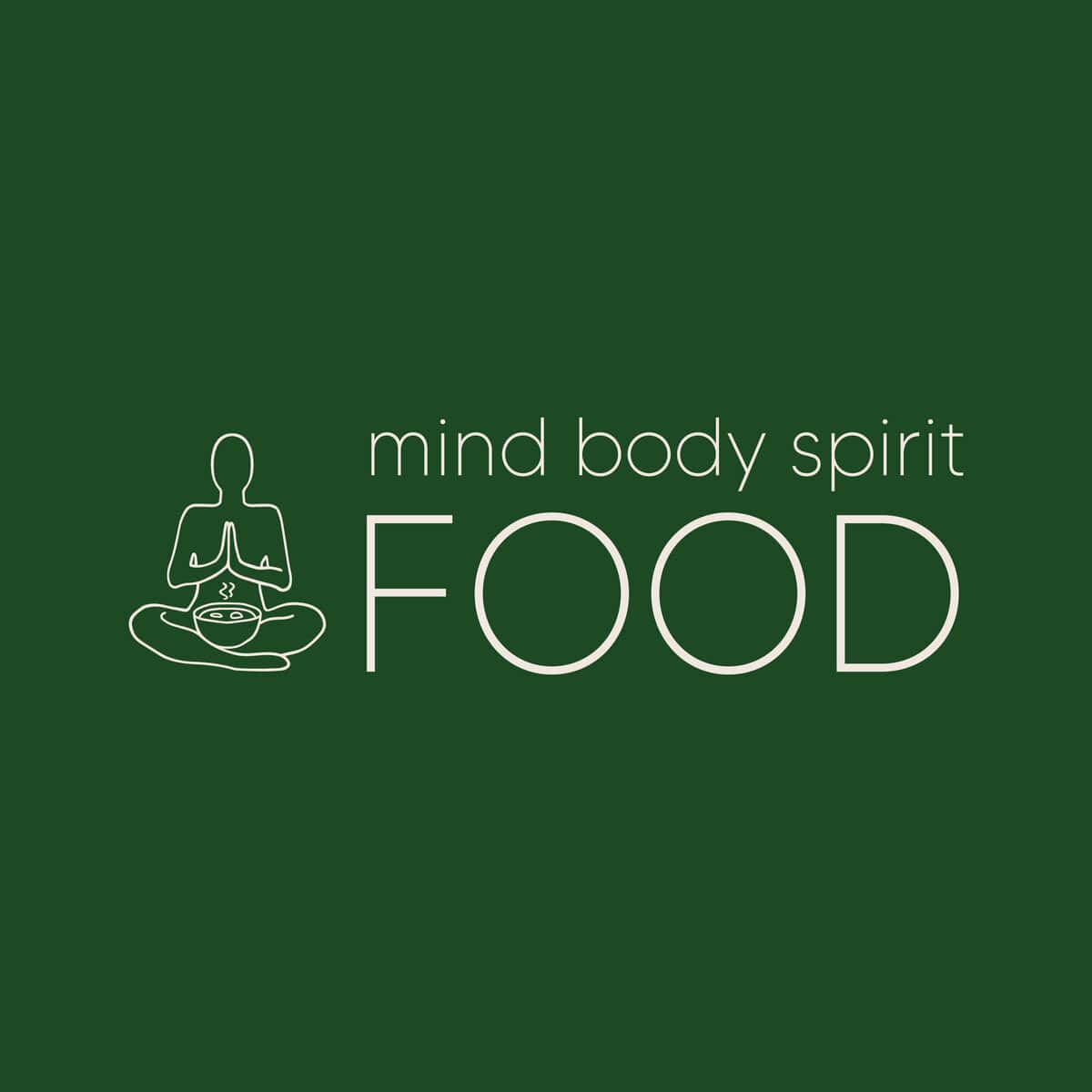
I am in the process of making this pie crust - I'm very hopeful! I am making pecan pies. Do you recommend par baking the crust? Seems the sugary content may seep under the crust if I do. Any recommendations? I will be back to let you know how they turn out.
Also, I make my own gluten free flour. If these turn out well with it, I will share that recipe. Thanks !
Hi Robin! I'll be curious to hear how the dough works with your homemade flour. Keep me posted! I recommend blind baking the crust for custard pies (such as pumpkin), but it's not needed for apple and usually pecan pies. However, if your filling is quite liquid-y (which is sounds like yours might be), then blind baking is a good idea. It won't hurt and will ensure a crispy, flaky crust! Happy baking!
Hi Nicki - the crust turned out fantastic! I made one pecan pie blind baking the crust and one that I did not blind bake the crust. Because of the holes in the crust and shrinkage cracks from blind baking, the filling leaked under the crust even though I tried to 'patch' the holes with egg wash. The second pie turned out terrific with no leakage and the crust was delicious! My gluten free flour mix really worked well with this technique and I'll never make a pie crust any other way. Thank you for this fabulous recipe! Happy to share my flour recipe if anyone is interested.
Hey Robin! So glad your pie came out delicious! Please share your gf flour mixture! I would love to try it as I’m new to trying to make my own gf mixtures and it’s been so hard to find the right combination. We are new to the whole gf world. Thanks so much! 😊
Hi Robin, may I have your gf flour mix recipe?
Hi!
I love this pie dough recipe. I made your spinach galette, and it turned out perfect! Currently, I have the dough thawing in the refrigerator. My question for you: If I want to make my pumpkin pies tomorrow, do I need to par-bake the pie crust? Or do I put the pumpkin pie filling directly into the uncooked pie crust? I usually do the latter, but didn't know if this recipe was different. Thank you for sharing all your recipes. And Happy Thanksgiving! Debbie
Hi Debbie, I'm so glad you like the pie dough! For pumpkin pie, I definitely recommend blind baking the crust (the instructions are in the recipe). That will ensure the bottom crust is crispy, not soggy. Let the crust cool, then pour in the filling and bake as directed. If needed, you can tent the edges with foil if they start to get too dark. I actually just blind baked a crust on my Instagram Stories if you want to hop over there and see (@fromscratchfast). Happy Thanksgiving!
Nicki, thank you for your quick response. I will follow the directions per your recipe and take a look at your Instagram. Many thanks. Debbie
I too have been disappointed with purchased GF crusts and pies. But this recipe actually works and I’m thrilled. My only complaint is that the crust sticks to the glass pie pan. Any fixes for that problem?
Thanks,
Linda
Hi Linda, I'm so happy to hear you like the crust! Are you using European style butter in the recipe? European style butter has a higher butterfat content, which would help prevent sticking. While I haven't had any trouble with sticking, you can also spritz the pie plate lightly with cooking spray or rub it lightly with softened butter, which would solve the problem. Happy baking!
Bookmarked this recipe a while ago and finally made the crust (plus yr apple galette) today - delicious! great taste, flavor and flakiness. I am thrilled - 20 yrs GF and I know this is not an easy feat! My minifood processor was too small so I used just a bowl and a pastry cutter. Kerrygold butter - followed directions closely. Excited for all the possibilities with this pie dough!
ps I do all my GF baking with King Arthur AP GF flour bc I don't like xanthan gum effects - but, I made an exception for this recipe and used the Cup for Cup. I do think you have to use this particular flour to that nice browning and flakiness you want in a pie crust.
Woohoo! Thank you so much for your comment, and I'm thrilled to hear you loved the pie crust!
Wow! This was the first gluten-free pie crust I've made and I loved how flakey and delicious it was! I appreciated that this recipe used ingredients I already had on hand. I used King Arthur's GF flour (again, new to GF so I'm not sure how it compares to others). Thanks so much for this easy, delicious recipe!
Hi Becca, thank you so much for your comment, and I'm so glad you liked the crust!! Great tip about using King Arthur GF flour. 🙂
It says:
2 ½ cups (326g / 11.5oz) Cup 4 Cup gluten-free flour OR 2 ½ cups (319g / 11.25oz) all-purpose flour, plus more for workspace
I don't know what this means. I thought it meant 2 1/2 cups gluten free flour and I wasted my time and a lot of butter. You should edit things properly before you post a recipe
Hi Sue, I'm sorry if these measurements were confusing for you. The measurement is indeed 2 1/2 cups of flour. I also include the weights for the Cup 4 Cup flour and the all-purpose flour, as many of my readers use a kitchen scale to weigh their flour instead of using measuring cups (hence the grams and ounce measurements). I hope this makes sense!
This was amazing! I made GF chicken pot pie and it was just as good as using regular flour. Thanks so much for the recipe!
Woohoo! Chicken pot pie is one of our favorites as well!
Best ever - for savoury and sweet pastry this is a winner!
I’ve made apple, pear and honey pie, tomato tart and beef, cheese and apple pasties and all have been terrific.
Rolling out between sheets of baking paper means get a lovely even and thin pastry.
I’m in Aust and used Red Mill 1 for 1 cup flour.
Hi Jill, I'm so happy to hear this (and I'm so impressed with all of the delicious tarts you've made!).
I am excited to try this recipe after reading all the great feedback. I was looking to see if anyone else asked about the Apple Cider Vinegar component, but didn’t see any. Is this absolutely necessary? If you leave it out, what would be the result? I believe I read it adds to the flakiness but don’t want to have a vinegar flavor note in the crust. Thanks
Hi Dana! The apple cider vinegar helps ensure the crust stays flaky and tender. You won't taste it at all!
This is delicious! So flaky and buttery! Definitely the best gf pie crust I've made.
Hi Samantha, I'm so happy to hear!!
Hi, Nicki,
I used this recipe and was only able to blind bake the pie dough for 1 5 minutes before it turned dark brown and very hard. I used it in a cherry pie and It required baking at 400 degree for 45 minutes. I had to take it out at 20 minutes and the crust was already very hard and after the pie cooled, it was very very hard to cut.
Have you encountered this problem?
Hi Jennifer, I'm so sorry you had trouble with the crust! The crust should definitely not be hard to cut, as it's quite tender. If the edges start to brown too quickly you can tent them with foil (tent the edges around the rim of the pie). Also, for cherry pie you probably don't need to blind bake the crust. Did you use Cup 4 Cup flour? Also, could you tell me what kind of butter you used in the crust?
Wow, because of the insane seen number of pop-ups I couldn't even tell what I was doing and left my feedback for this recipe under a different recipe. All I wanted to say was that there was no way in the world that this saves to use another day. Turned into an unusable rock. Never. Again.
Hi Karina, the dough will indeed harden in the fridge (it will feel very hard straight out of the fridge), but you just need to let it soften at room temperature for 15-30 minutes before rolling out. It will soften enough to roll (you'll know it's too cold if it starts to immediately crack when rolling - if that's the case then let it sit for a few minutes longer). I hope this helps!
This was AMAZING! I used it for gluten free turkey pot pie. I didn't even have European butter and it was still awesome. I actually ran out of GF flour so used masa flour to roll the dough and it gave the crust a nice extra crunch. I plan to make this again and again so thank you so much for posting!! I never thought I would be able to make a good pie crust and your recipe changed my mind!
Hi Brynne, I'm so happy you liked the pie crust (that turkey pot pie sounds amazing), and I love the idea of adding some corn flour for texture!
How much butter?
How much salt?
How much ACV?
Didn't see it in the recipe.
Not sure how to interpret a splash of vinegar or a touch of sugar please.
Thank you
Hi there, if you scroll up you'll find the full recipe with all of the measurements! (Right below the header, "Get the Recipe!") I hope you enjoy!
Hello would the Cup 4 Cup pie crust mix work instead of the regular blend? Not sure if it’s the same or not. Thanks!
Hi Romy! I believe that the pie crust mix is different than the regular GF flour, so I'd stick with that. Good luck!!
This comment is so helpful! Thank you!!! I will go get some cup for cup. I also resisted because it is so high, but for the holidays... I'll cave! ha! I also made it with Bob's Red Mill (my go to for baking) and it was a little hard. Good, but a little hard.
Hi Traci, the Cup 4 Cup really does make a difference. I hope you enjoy, and Happy Holidays!!
I made this with bob mill’s gluten free 1 to 1 baking flour and followed all ingredients and steps as written. I give it 5 stars!!!! Baked my pie in a cast iron skillet and it may be the best crust I’ve ever had even in comparison to regular non gf crusts !!!! Crisps up nicely and is flakey and buttery. Everything I want in a pie crust. Tried it with an apple filling, looking forward to trying with pumpkin, French silk, banana cream....
Hi Sarah, I'm so happy to hear this! I love how you baked the crust in a cast iron skillet - I bet that looked beautiful. Happy baking!
This recipe looks great and I'll be using it for my pumpkin pie this year! Is it possible to substitute some of the butter for shortening, like 1/2 butter and 1/2 shortening? I've often used shortening and butter in my recipes to give the crust some extra tenderness, but I don't want to mess with the ratios if it won't work!
Hi Yvonne! I suggest using all butter in this crust recipe, as the butter creates a very flaky, tender texture and also gives the crust a wonderful flavor. I hope you enjoy, and happy Thanksgiving!
Hi Nicki,
I have yet to try this recipe but, I was so excited when I saw how amazing your gf crust looked because my whole family has been gluten free for 4 years now and we have yet to find a good flaky pie crust recipe. I just had one quick question about the recipe, I was just wondering if this recipe would still work if I used lard instead of European butter?
Hi Dianna! While I haven't tested this recipe with lard, it *should* work as a 1-to-1 swap with the butter. However, you might need to add a touch more liquid depending on how dry the lard is, and you will lose some of the flavor that the butter imparts. Please let me know if you give it a try, and happy baking!
Well, this is weird.
Posted by Nicki Sizemore | Nov 11, 2020 and I recievd this in my RSS feed this morning.
There are 36 comments going back through 2018!!
Is this a repost?
Hi Kathleen, I just did a big update to this post and added a new video, hence the new date! The original recipe has lived on my blog for years. I hope you enjoy!
Hi Nicki,
Can I use Kerrygold regular (salted) butter instead of unsalted. Anxious to try your recipe!
Hi Carol! You can use the salted butter, but omit the salt from the recipe. I hope you enjoy!!